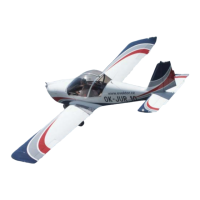
Do you have a question about the EVEKTOR-AEROTECHNIK SPORTSTAR and is the answer not in the manual?
| Brand | EVEKTOR-AEROTECHNIK |
|---|---|
| Model | SPORTSTAR |
| Category | Tools |
| Language | English |
Table for recording manual revisions, affected pages, dates, and approvals.
Lists all effective pages in the manual with their respective dates.
Provides an overview of the flight manual's purpose and content.
Details the standards the aircraft meets for airworthiness.
Explains the meaning of standard safety indicators used in the manual.
Covers airplane description, powerplant, technical data, and three-view drawing.
Lists and defines abbreviations and terms used throughout the manual.
Overview of section content: operation limitations, instrument marking, and basic placards.
Details airspeed limitations and their meanings for various flight conditions.
Explains the color-coding and significance of airspeed indicator markings.
Provides specifications for the engine, propeller, and related systems.
Lists empty weight, maximum take-off, landing, and baggage weights.
Specifies the maneuvers approved for SPORTSTAR airplane operation.
Shows placards related to limitations found on the instrument panel and canopy.
Describes emergency situation solutions and procedures for aircraft operation.
Lists recommended airspeeds for various emergency landing scenarios.
Covers procedures for engine failure during takeoff run, takeoff, and flight.
Details procedures for engine fires on ground, during takeoff, and in flight.
Outlines procedures for various emergency landing scenarios.
Provides the standard procedure for recovering from an unintentional spin.
Describes normal operations and recommended procedures for airplane flight.
Lists recommended airspeeds for takeoff and landing phases.
Provides a detailed procedure for conducting a pre-flight inspection of the aircraft.
Outlines step-by-step procedures and checklists for various flight phases.
Introduces section on airspeed calibration, stall speeds, and takeoff/landing performance.
Presents calibration data, stall speeds, takeoff, landing, and climb performance.
Includes data on cruise, endurance, crosswind, ceiling, and noise.
Explains determination of CG position and allowed loading range.
Provides a template for recording aircraft weight and balance changes.
Details the permissible payload ranges for the aircraft.
Describes the airplane's systems and their operation.
Details the fuselage, wing, and tail unit construction.
Explains longitudinal, lateral, rudder, and elevator trim controls.
Illustrates and lists cockpit control elements and their functions.
Describes the landing gear system and hydraulic disk brakes.
Covers engine details, control, instruments, cooling, lubrication, intake, and ignition.
Covers procedures for airplane handling, maintenance, and operation recommended by manufacturer.
Details intervals for periodical inspections and reviews of the airplane.
Outlines procedures for towing, parking, anchoring, jacking, and levelling.
Provides instructions for draining fuel tanks prior to the first flight each day.
Details recommended cleaning agents and methods for the airplane surface and canopy.
Contains supplements for optional systems and equipment not in the standard airplane.
Lists supplements, their document numbers, and titles.
Indicates which supplements are included in the flight manual.
